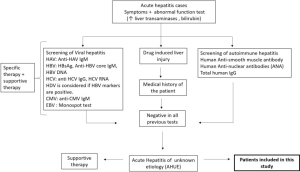Hepatitis E virus (HEV) is a neglected pathogen in Egypt. Although, the initial studies conducted on HEV in Egypt in the past two decades showed high seroprevalence of anti-HEV IgG among villagers and pregnant women, till now, there is no routine diagnosis for HEV in most Egyptian hospitals. The reasons for this ignorance are related to the limited funding sources which were directed to other endemic viruses such as HCV and HBV. Besides, not all complications associated with HEV infections were identified by this time. Importantly, the majority of the previously recorded HEV cases among Egyptians were self-limiting, giving an initial indicator that the circulating viruses in Egypt were attenuated isolates
Dr. Ibrahim M Sayed, Dr. Haidi Karam-Allah Ramadan, and Dr. Mohamed A. El-Mokhtar from Assiut University tell the latest developments in Egypt.
Recently, we started screening for HEV in patients with acute hepatitis of unknown etiology (AHUE) (Figure 1). We found about 10% of these cases were positive for HEV markers.

Figure 1: Routine diagnosis of acute hepatitis in Egyptian hospitals
Most of the detected cases were acute infections of HEV genotype 1. Although the majority of patients were self-recovered, few patients progressed to fulminant hepatic failure (FHF). During acute phase of the infection, the level of liver transaminases was higher in patients who progressed to FHF compared to acute self-limited patients. In addition, anti-HEV IgM, and HEV Ag, but not HEV RNA were elevated in FHF patients than in self-limited ones. We followed the kinetics of the previous markers in a few patients during FHF progression, and we found that anti-HEV IgM and HEV Ag concomitantly increased, which could explain the mechanisms of HEV induced liver injury via the precipitation of excessive immune complexes. The level of HEV RNA was reduced or not affected during FHF progression, suggesting that the liver damage is not linked to the multiplication of virus inside the liver (Figure 2). FHF patients were either older age, had leukemia, or with a previous history of liver diseases.

Figure 2: Kinetic of HEV Ag in the patients developed FHF and its correlation to HEV markers.
In conclusion: Acute HEV infections are recoded among Egyptians which could have severe complications. HEV diagnosis becomes essential in hospitals, and it should be initiated urgently and promptly.
These studies were conducted in Assiut University Hospitals in the period between 2016-2020.
To read the full articles
https://www.tandfonline.com/doi/full/10.1080/21505594.2021.1922027

